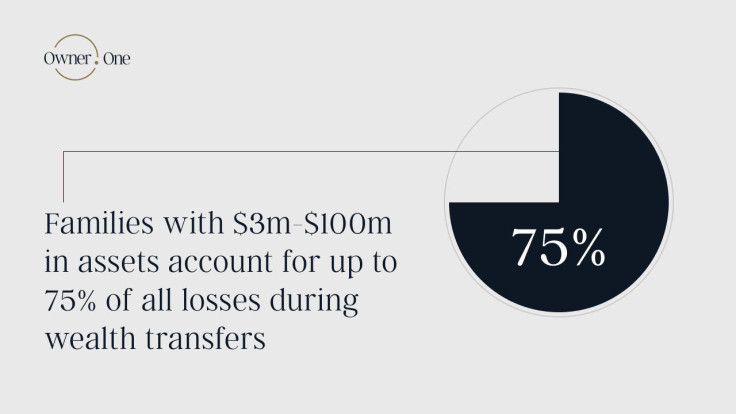Why Information Asymmetry Slices 30% Off Family Fortunes

In the next 20 years, millennials are poised for the biggest wealth handover ever seen. Though the road to financial success seems clear, a hidden challenge awaits: information asymmetry within families. This issue could chip away at $310,000 from every $1 million in family wealth. How can this be prevented?
High-Nets Lose More Than Others
$90 trillion worth of assets will move between generations, as estimated in Knight Frank.
A report by Owner.one, which represents the responses of 13,500 high-net capital founders from 18 countries, shows that most wealth owners are unprepared for it. Families worth $3 million to $100 million are most vulnerable during the transfer from one generation to another. They account for up to 75% of all losses.
According to Capgemini's Global Wealth Report 2023, the global high-net-worth individual (HNWI) population, totaling US$83 trillion in wealth, faces this risk.

Understanding Information Asymmetry
Owner.One's study shows that only 2% of capital founders know that, on average, up to 31% of family wealth is lost during transfer due to gaps in data.
Navigating family wealth is like exploring a dense jungle. What's visible on the path ahead represents only a part of the entire ecosystem. In summary, we cannot see the roots that drive its growth and flourishing.
This situation is reminiscent of information asymmetry, where the true nature of the family's wealth—its diverse asset classes, legal entities, geographical spread, vital contacts, and binding agreements—remains known only to the wealth owner.
The Owner.One report indicates that successfully transferring assets requires knowing up to 22 different attributes for each asset. The knowledge gap between the capital founder and family members often results in difficulties locating and claiming rights to the assets.
Founders' Ignorance Dilemma
81.6% of capital founders do not act to resolve information asymmetry.
Less than 5% understand that it shifts the wealth transfer problem to their family and children. They will not have the necessary tools to tackle it.
Only 11.9% of parents are aware that their children must go through Know Your Customer (KYC) procedures for both themselves and their parents, as the founder must trace family assets and capital back.
However, only 6.1% have a Source of Wealth Essay (SoWE). It's the main document to trace the origins of family wealth.
As a result, a net worth of $3M to $99M is considered to be wealth that will not last beyond one generation. In 69% of cases, a family's lifestyle gets worse after the transfer.
Why Families Reach Only 'Low-Hanging Fruits?'
The report shows that capital founders lose up to one-sixth of their asset data annually, often irretrievably.
It's no surprise that 68% of capital founders feel significant stress over securely storing and transferring asset information to their families. A striking 87.1% keep their personal and family wealth records at poor to moderate levels. 97.3% opt for insecure storage methods.
Only 7% acknowledge that during emergencies, there's typically a 3-6 month period to claim assets in most countries. Without comprehensive asset data and attributes, heirs will be limited to reaching only the 'low-hanging fruits'.
High-Nets Anticipate New Services, Yet Find No Available Options
The survey indicates that traditional financial institutions are not meeting the needs of UHNWIs and HNWIs, with only 0.4% using family trusts and 0.7% having family offices.
The new generations of wealth owners look for modern, technology-driven setups. In fact, 71.4% of capital founders are open to relying on third-party services, provided they operate autonomously without human intervention—a capability not currently offered by existing products or services.
Owner.One has just launched its service to address the information asymmetry problem for high-net-worth families.
It functions as a 'judgment day envelope.' If something happens to the capital founder, it ensures that essential information skips intermediaries and goes straight to the intended recipients.
The blockchain setup ensures secure storage and utilizes self-executing algorithms to transfer necessary data at the exact moment under predefined and unalterable conditions.
© Copyright IBTimes 2024. All rights reserved.




















